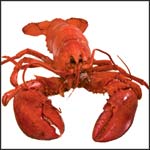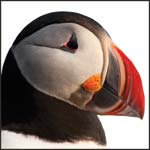Iceland – the northern light of the culinary world
Agnar Sverrisson (left), chef and co-owner of London's Michelin-starred Texture restaurant, takes Kerstin Kühn on a culinary tour of his home town of Reykjavik
Iceland hasn't been the most popular of countries in recent history. First there was the major economic crisis and then the eruption of the unpronounceable Eyjafjallajokull, whose volcanic ash cloud caused chaos for thousands of travellers around the world last spring. But there's so much more to Iceland, especially when it comes to food.
Like its Scandinavian neighbours, Icelandic cuisine celebrates the Nordic culinary ethos, with its foundations rooted in simplicity, purity and loyalty to seasonal, local produce. In London, Icelandic chef Agnar Sverrisson is waving the flag for his home land at his Michelin-starred Texture restaurant, which he owns with Xavier Rousset, where he offers Nordic cuisine at its best. Here he showcases top quality produce from Iceland, from halibut to seaweed, Skyr, lamb and brennivín.
Last year, Sverrisson invited Caterer to his home town of Reykjavik where he gave us a taste of the country's culinary heritage and the traditions he reinvents at Texture.
Iceland is a vast island with a population of just 320,000, more than half of which lives in Reykjavik and its surrounding area. So it's no surprise that Icelandic restaurants are at their densest in Reykjavik, where nearly every type of cuisine is available, from US fast food to Italian or Oriental.
celebrating home-grown produce
However, it's the restaurants adhering to their Icelandic roots and using local ingredients such as halibut, langoustines, cod, haddock, beef and lamb that stand out. Icelandic chefs used to rely heavily on foreign foods and imported produce from France, but more recently the industry has begun to celebrate its heritage and home-grown ingredients, according to Sverrisson.
These restaurants have two distinct approaches, with some chefs pursuing a modern method, often inspired by Rene Redzepi's cooking at Noma in Copenhagen, and others returning to more traditional Icelandic cooking. The latter use ingredients you'd be hard pressed to find on menus outside Iceland.
Fish restaurant 3 Frakkar, for instance, located in the residential heart of Reykjavik, offers Icelandic specialities such as Hákarl, smoked puffin breast and whale meat, which is served either as sashimi or marinated with melon and horseradish sauce.
"We serve minke whale, which is not endangered, and use the lower end of the loin, which is the best part," explains chef-patron Úlfar Eysteinsson. One of the restaurant's specialities is a dish every Icelander will have eaten and cooked at home: plokkfiskur, or hashed fish served with potatoes and black rye bread.
Meanwhile, more contemporary Icelandic restaurants draw as much on local ingredients but apply a more modern approach in their cooking techniques. At VOX, in the Hilton Reykjavik Nordica hotel, executive chef StefÁ¡n Vidarsson serves a menu of New Nordic cuisine with dishes including sautéed langoustine and slow-cooked scallops with beach rose, carrots, pickled rose petals and rye bread (see recipe, page 49); or raw reindeer from JÁ¶kuldalsheiÁ°i with chanterelles and wild Icelandic berries.
"Noma has been a big inspiration for us," says Vidarsson. "It really opened our eyes to the amazing produce we have around us."
Iceland's seasons range from green shoots and mild days in the spring to heavy rains and red vegetation in the autumn. Unsurprisingly, the winters are relentless, and with there not being much fresh produce around during the colder months, chefs rely on frozen meat and fish, root vegetables and preserved ingredients that are often smoked, cured or pickled.
Nordic connections
One of Vox's more recent competitors is fine-dining restaurant Dill at the Nordic House, a centre designed to cultivate connections between Iceland and other Nordic countries. Launched in 2009 by chef-sommelier duo Gunnar Karl GÁslason and Á"lafur Á–rn Á"lafsson, Dill adheres to the "manifesto of the new Nordic kitchen," according to Á"lafsson.
"This has its roots in the Slow Food movement and we source 90% of our produce from Iceland," he says. Typical dishes include smoked Arctic char, parsnip, seaweed and mushrooms; and cod in birch oil with peas, chives and mushrooms.
Staffing
Reykjavik's restaurants have small brigades - typically no more than three or four chefs per kitchen. "Staffing costs in Iceland are high so brigades are kept small," explains Sverrisson.
The Blue Lagoon, about an hour outside Reykjavik, is one of Iceland's biggest tourist attractions, which welcomes more than 400,000 visitors each year. Executive chef Magnus Hedinsson manages a restaurant, café and bar catering for up to 400 diners for receptions and 150 Á la carte. His brigade is made up of just six chefs (plus five students), with the team preparing everything fresh on site.
Meanwhile the five-star 252-bedroom Hilton Nordic hotel has a brigade of 14 chefs. "Our chefs can work no more than 200 hours per month," explains Vidarsson. As well as 24-hour room service and banqueting, his team runs two restaurants including VOX, one of Reykjavik's most acclaimed restaurants.
"In Iceland many chefs look at their work very much as work," says Sverrisson. "It's not the same as in the UK and chefs don't work 16-hour days like they do over here. You get paid overtime so can earn a great salary if you do work the extra hours."
TOP ICELANDIC RESTAURANTS
Argentina Steakhouse
A Reykjavik staple since the late 1980s, this restaurant's focus is on Icelandic beef from the open fire grill but local lobster, langoustines and lamb are also offered.
Gallery Restaurant
Housed in the Hotel Holt and co-owned by father and son duo EirÁkur Ingi FriÁ°geirsson and chef de cuisine FriÁ°geir Ingi EirÁksson, whose cooking is rooted in classic French cuisine. The signature dish is its home-smoked salmon.
GrilliÁ° Restaurant
Located on the top floor of the Radisson Blu hotel, this is one of Reykjavik's most acclaimed fine-dining restaurants offering dishes ranging from fresh halibut with carrot and oranges to beef tenderloin served with Jerusalem artichokes and dates.
La Primavera
Contemporary restaurant influenced by the flavours of Northern Italy mixed with local Icelandic produce. The signature dish is linguini with Icelandic langoustine, chilli and garlic.
Restaurant 3 Frakkar
Traditional Icelandic cuisine with a focus on seafood including puffin, whale and shark.
The Lobster House
Located in the heart of the Icelandic capital, this restaurant is best known for its lobster and seafood but also offers Icelandic specialities including horse meat.
VOX
Divided into a bistro and fine dining restaurant, Vox at the Hilton Reykjavik Nordica hotel offers both simple food and ‘New Nordic' cuisine prepared using fresh, local ingredients.
The Blue Lagoon
About an hour's drive from Reykjavik, this is one of Iceland's biggest tourist attractions, which features a café, bar and restaurant offering signature dishes such as lobster soup.
Icelandic lamb
Due to the tough weather conditions the season for Icelandic lamb is extremely short, running from August until October (Easter lamb is available in April and May). This means chefs rarely get their hands on fresh lamb and have to rely primarily on frozen meat. However, according to Sverrisson this doesn't compromise quality.
"Freezing the meat breaks down the protein and can help to tenderise it," he explains.
For more info on Icelandic lamb and details of suppliers, visit www.icelandlamb.is
Traditional Icelandic foods and ingredient
HÁ¡karl Icelandic for "rotten shark", it is made with Greenland or basking shark which ferments buried in the ground for up to six months and is then hung to dry for four to five months. It's no doubt an acquired taste but while its pungent fishy and ammonia-rich smell might put you off, its taste is quite mild.
Plokkfiskur Hashed fish traditionally made from leftovers served with potatoes, spices and béchamel sauce, topped with cheese and put under the grill. The dish is usually accompanied by black, cakey rye bread.
Skyr A hugely popular Icelandic dairy product made from pasteurised skimmed milk. It is similar to strained yoghurt but is technically a very soft cheese. Skyr is traditionally served cold with toppings such as sugar and cream or berries and has a slightly sour dairy flavour with a hint of residual sweetness.
Whale An ongoing cause of controversy, whale meat continues to be served in Iceland. The species used is minke whale, which in the north-eastern Atlantic has a population estimated to be more than 100,000. It is usually served grilled, smoked or raw as sashimi.
Icelandic salmon gravadlax, rye bread, cucumber, horseradish by Agnar Sverrisson >>](http://www.caterersearch.com/Articles/2011/02/23/337157/Icelandic-salmon-gravadlax-rye-bread-cucumber-horseradish-by-Agnar.htm)
[Sautéd Icelandic langoustine and slow-cooked Faroese scallops with beach rose, carrots, pickled rose petals and rye bread, by StefÁ¡n Vidarsson >>](http://www.caterersearch.com/Articles/2011/02/23/337156/sautd-icelandic-langoustine-and-slow-cooked-faroese-scallops-with-beach-rose-carrots-pickled-rose-petals-and-rye-bread-by-stefn-vidarsson.htm)
By Kerstin KÁ¼hn
E-mail your comments to Kerstin KÁ¼hn here.
Caterersearch.com jobs
Looking for a new job? Find your next job here with Caterersearch.com jobs
|












